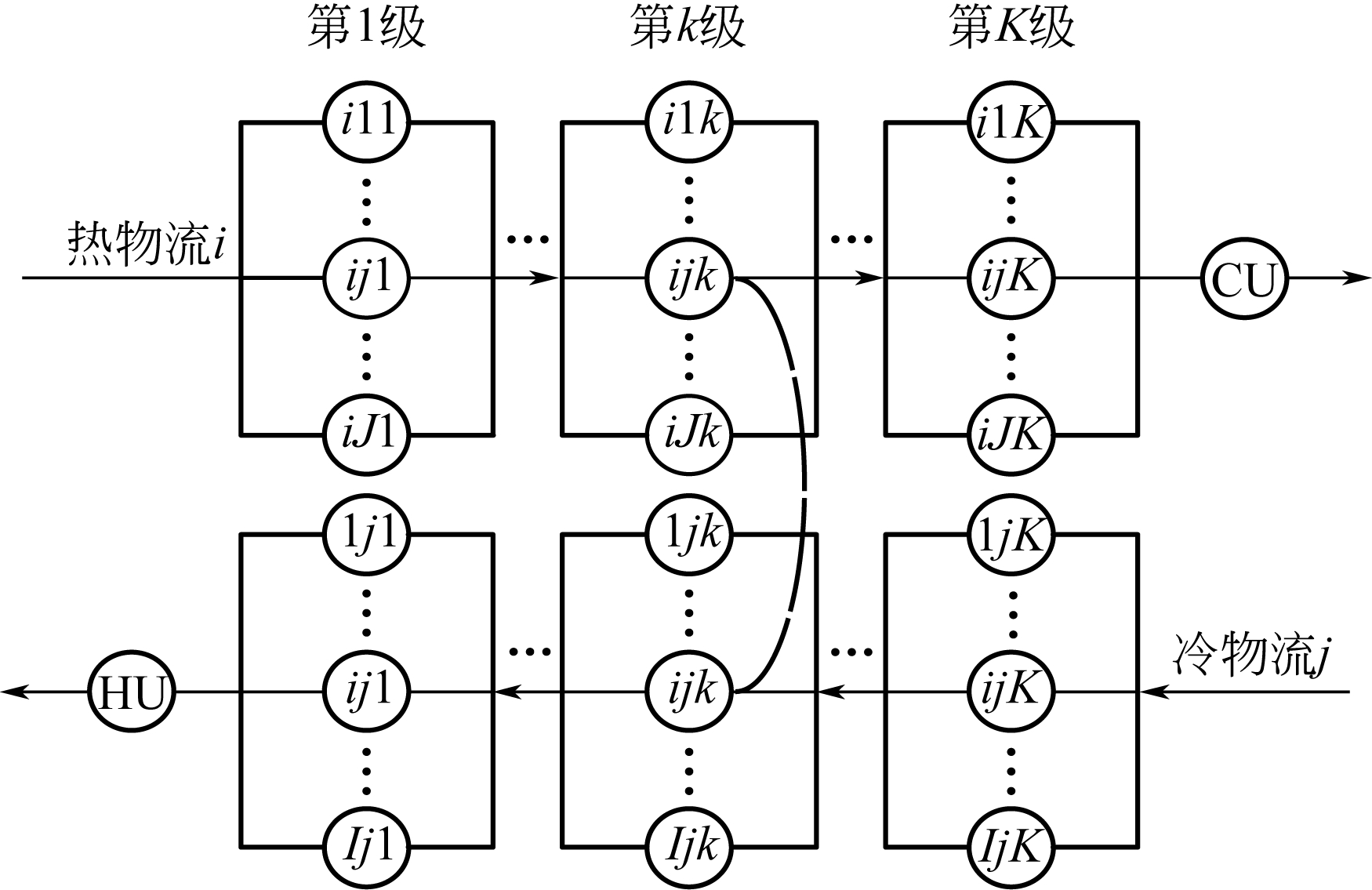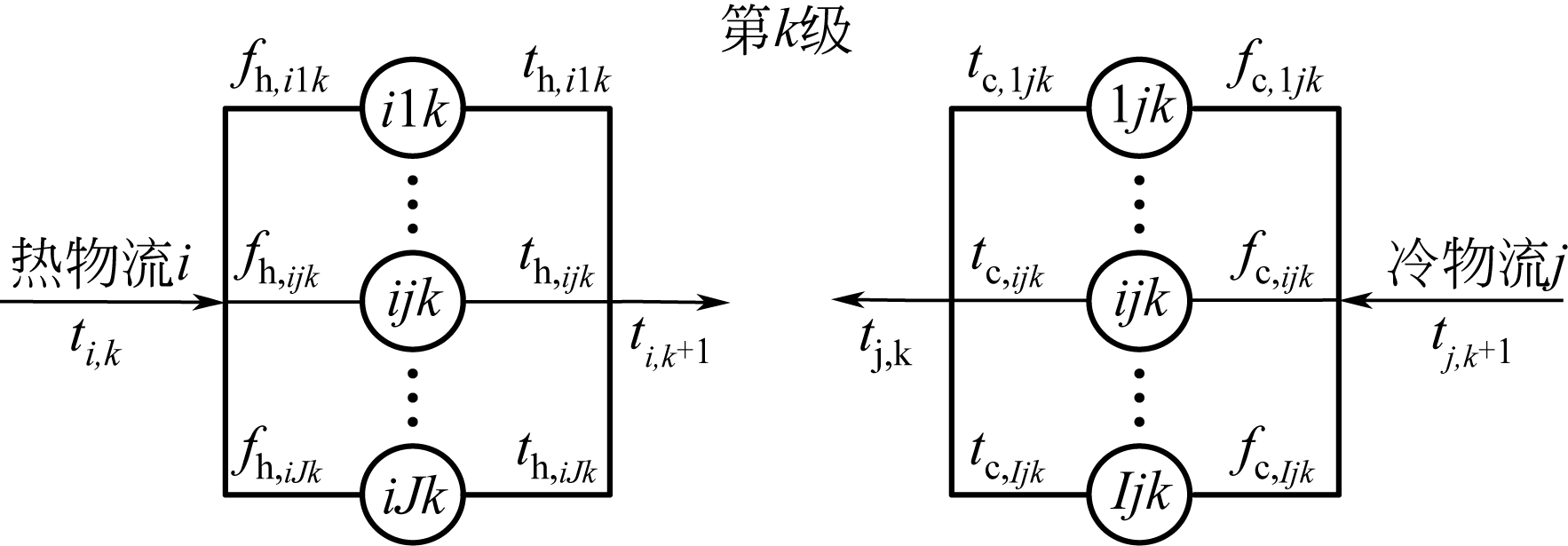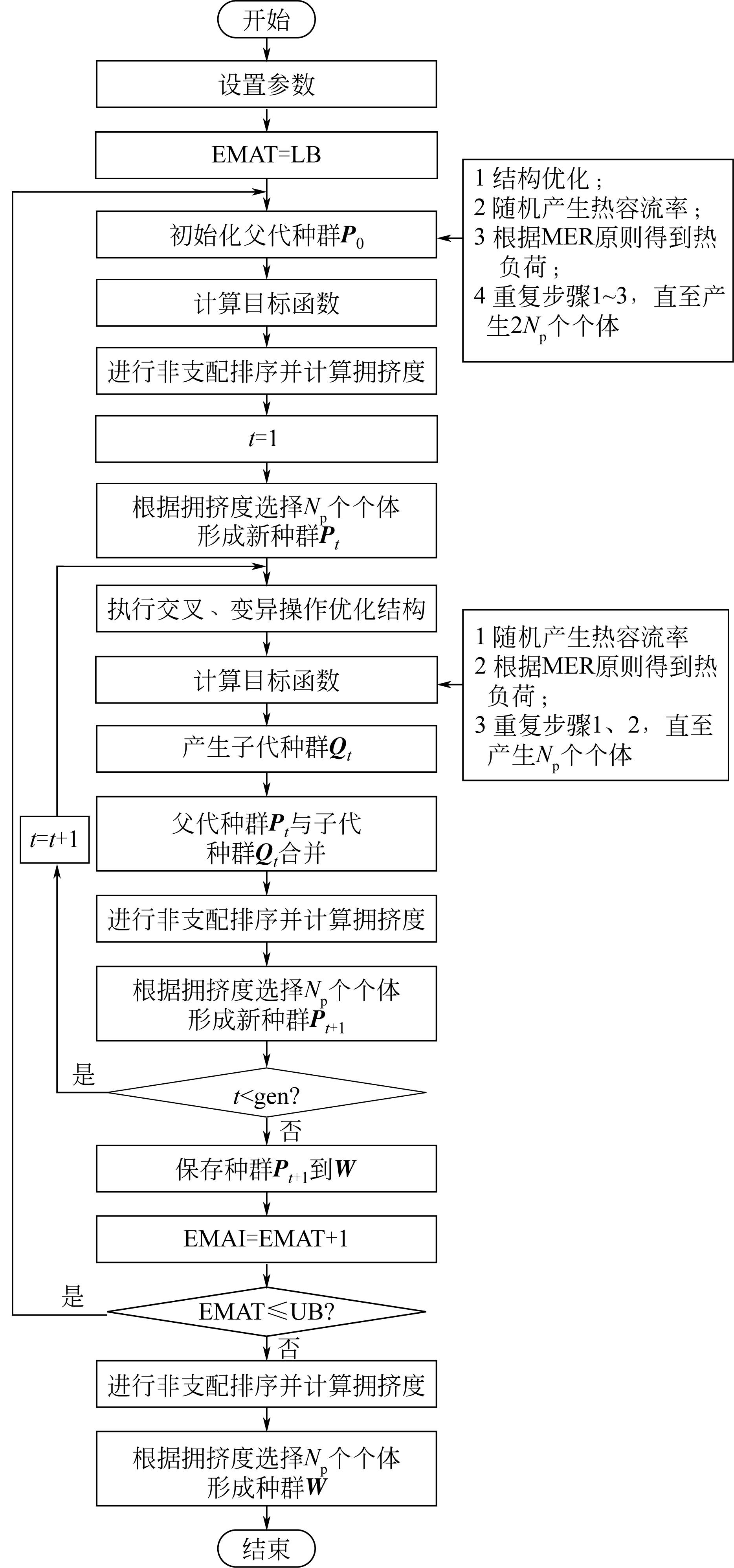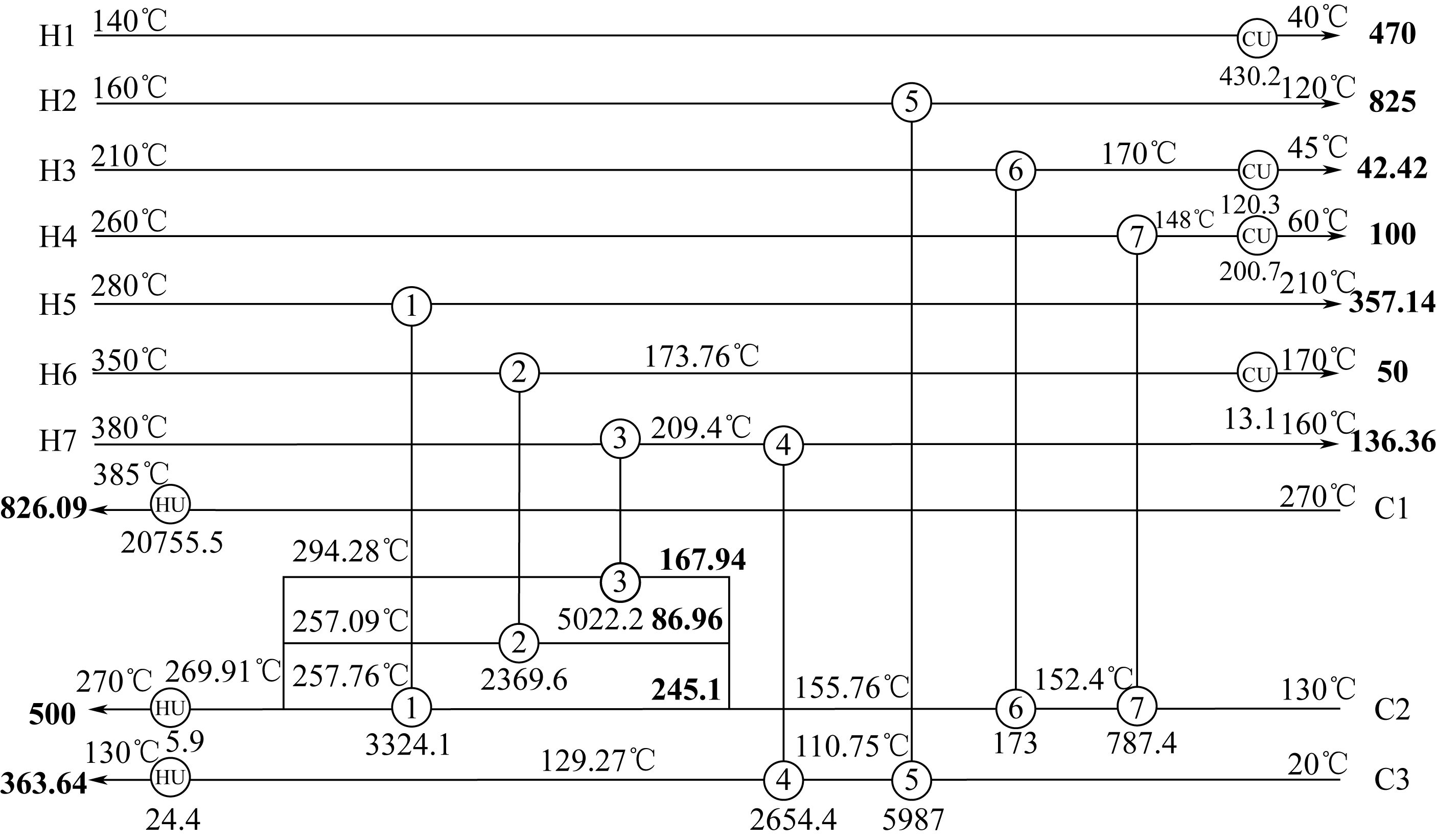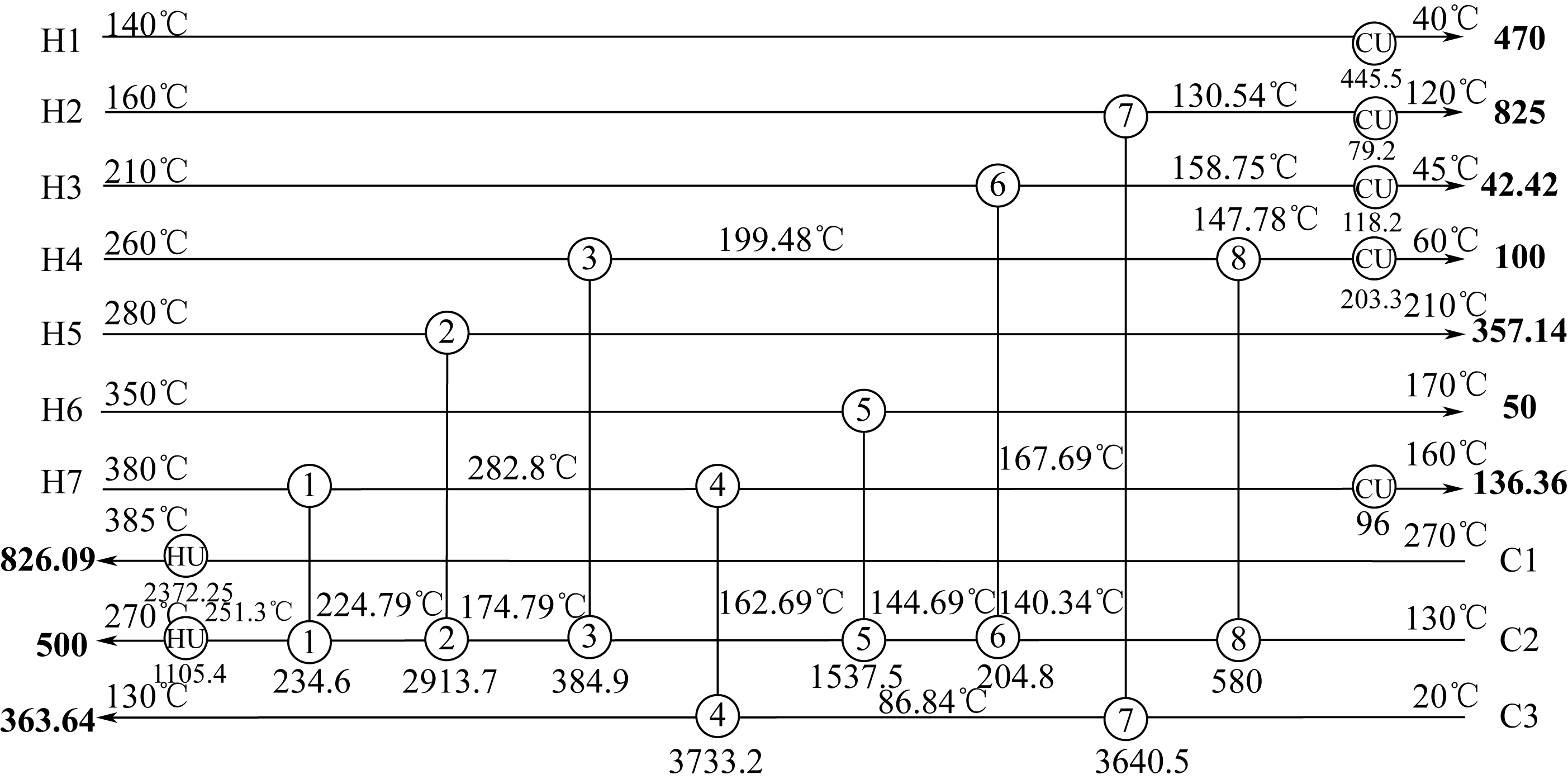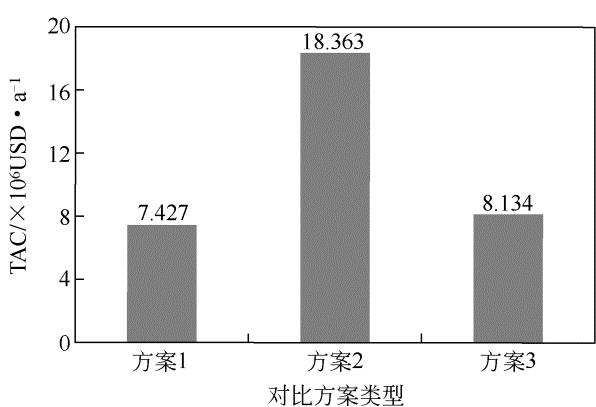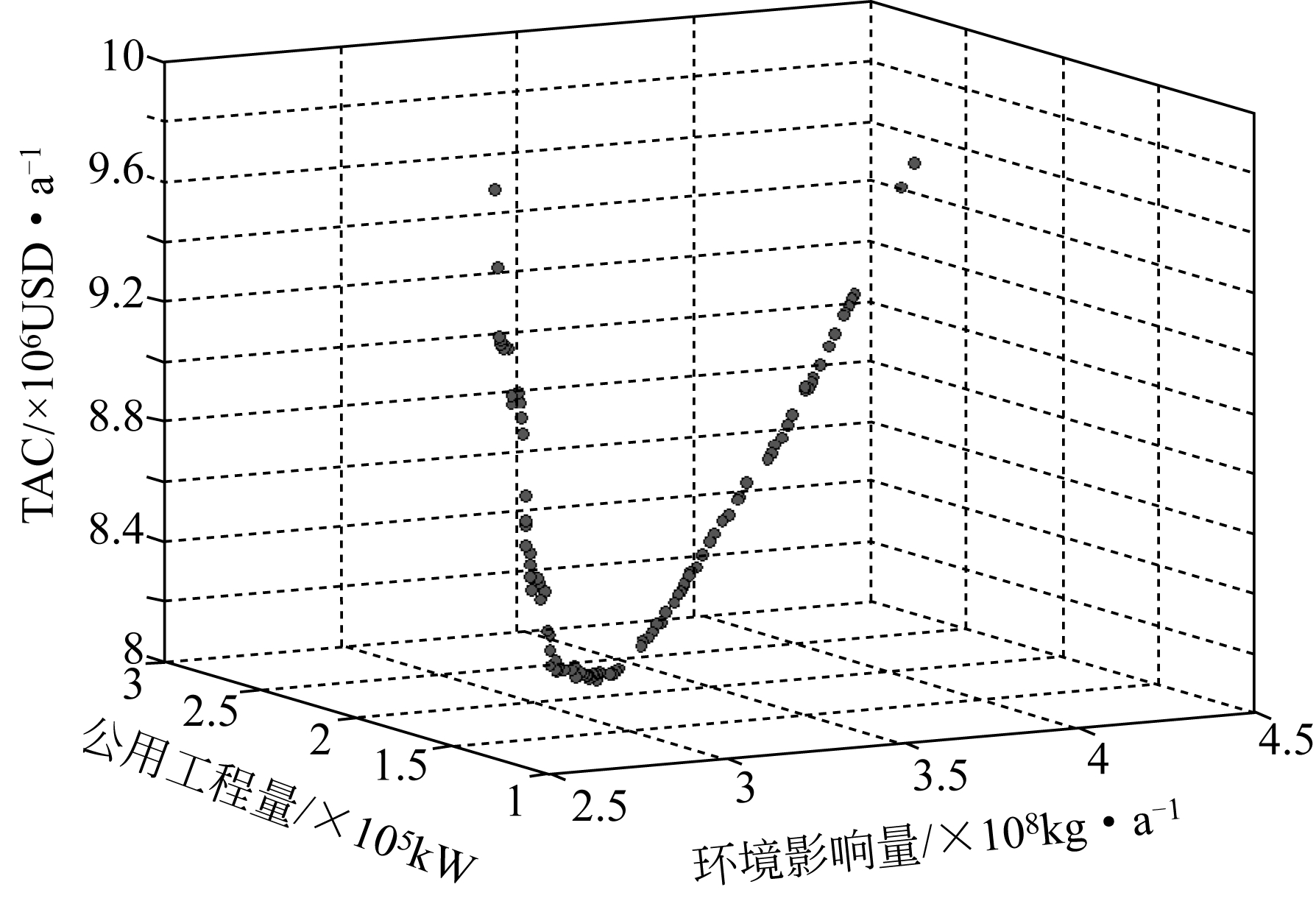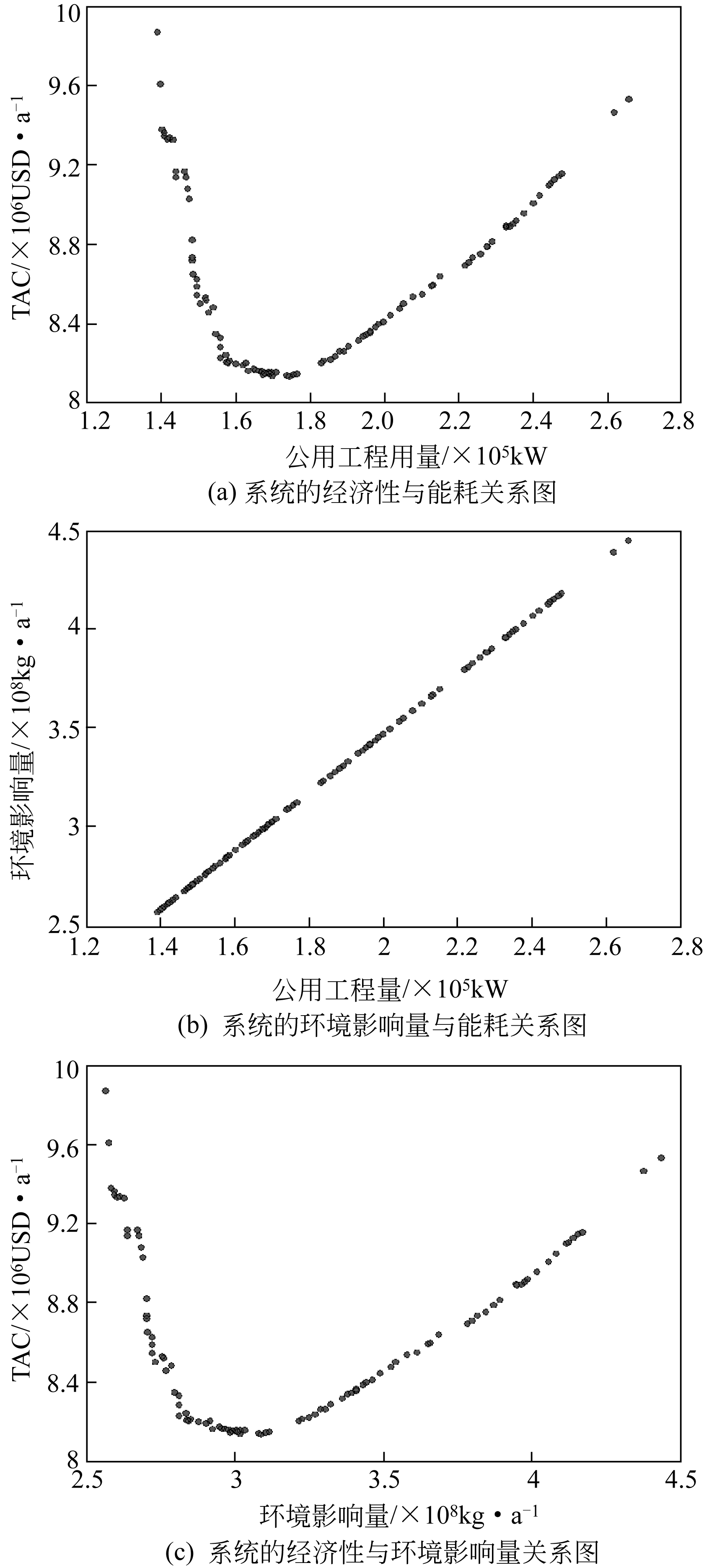Chemical Industry and Engineering Progress ›› 2019, Vol. 38 ›› Issue (02): 761-771.DOI: 10.16085/j.issn.1000-6613.2018-0857
• Chemical processes and equipment • Previous Articles Next Articles
3E Optimization of heat exchanger network system based on non-counterflow heat transfer
Ning JIANG( ),Fengyuan GUO,Wenqiao HAN,Huajing LIU,Lu LIN
),Fengyuan GUO,Wenqiao HAN,Huajing LIU,Lu LIN
- 1. College of Mechanical Engineering, Zhejiang University of Technology, Hangzhou 310032, Zhejiang, China
-
Received:2018-04-24Revised:2018-07-21Online:2019-02-05Published:2019-02-05
基于非逆流传热的热交换网络系统的3E优化
- 1. 浙江工业大学机械工程学院,浙江 杭州 310032
-
作者简介:第一作者简介::<named-content content-type="corresp-name">蒋宁</named-content>(1977—),女,博士,副教授,主要从事换热网络优化集成的研究。E-mail:<email>jiangning@zjut.edu.cn</email>。 -
基金资助:浙江省自然科学基金(LY18E060010);国家自然科学基金(51206147)
CLC Number:
Cite this article
Ning JIANG, Fengyuan GUO, Wenqiao HAN, Huajing LIU, Lu LIN. 3E Optimization of heat exchanger network system based on non-counterflow heat transfer[J]. Chemical Industry and Engineering Progress, 2019, 38(02): 761-771.
蒋宁, 郭风元, 韩文巧, 刘华菁, 林露. 基于非逆流传热的热交换网络系统的3E优化[J]. 化工进展, 2019, 38(02): 761-771.
share this article
Add to citation manager EndNote|Ris|BibTeX
URL: https://hgjz.cip.com.cn/EN/10.16085/j.issn.1000-6613.2018-0857
| 流股 | 进口温度 /℃ | 出口温度 /℃ | 热容流率 /kW·℃-1 | 换热系数 /kW·m-2·℃-1 | 费用 /USD·kW-1·a-1 |
|---|---|---|---|---|---|
| H1 | 140 | 40 | 470 | 16 | — |
| H2 | 160 | 120 | 825 | 2 | — |
| H3 | 210 | 45 | 42.42 | 0.9 | — |
| H4 | 260 | 60 | 100 | 0.8 | — |
| H5 | 280 | 210 | 357.14 | 0.4 | — |
| H6 | 350 | 170 | 50 | 0.1 | — |
| H7 | 380 | 160 | 136.36 | 0.08 | — |
| C1 | 270 | 385 | 826.09 | 0.8 | — |
| C2 | 130 | 270 | 500 | 0.44 | — |
| C3 | 20 | 130 | 363.64 | 0.08 | — |
| HU | 450 | 310 | — | 0.1 | 40 |
| CU | 20 | 25 | — | 2.3 | 4 |
| 流股 | 进口温度 /℃ | 出口温度 /℃ | 热容流率 /kW·℃-1 | 换热系数 /kW·m-2·℃-1 | 费用 /USD·kW-1·a-1 |
|---|---|---|---|---|---|
| H1 | 140 | 40 | 470 | 16 | — |
| H2 | 160 | 120 | 825 | 2 | — |
| H3 | 210 | 45 | 42.42 | 0.9 | — |
| H4 | 260 | 60 | 100 | 0.8 | — |
| H5 | 280 | 210 | 357.14 | 0.4 | — |
| H6 | 350 | 170 | 50 | 0.1 | — |
| H7 | 380 | 160 | 136.36 | 0.08 | — |
| C1 | 270 | 385 | 826.09 | 0.8 | — |
| C2 | 130 | 270 | 500 | 0.44 | — |
| C3 | 20 | 130 | 363.64 | 0.08 | — |
| HU | 450 | 310 | — | 0.1 | 40 |
| CU | 20 | 25 | — | 2.3 | 4 |
| 目标 | 方案1 | 方案2 | 方案3 | 方案4 |
|---|---|---|---|---|
| (FT=1) | (仅温差修正) | (FT≠1) | (FT≠1) | |
| 总面积/m2 | 41868 | 47501 | 41111 | 46117 |
| 换热设备单元 | 14 | 14 | 15 | 15 |
| 热公用工程/×104kW | 9.531 | 9.531 | 10.435 | 9.573 |
| 冷公用工程/×104kW | 6.131 | 6.131 | 7.035 | 6.173 |
| 总公用工程量/×104kW | 15.662 | 15.662 | 17.470 | 15.746 |
| 总投资费用/×106USD·a-1 | 3.370 | 14.305 | 3.679 | 4.165 |
| 公用工程费用/×106USD·a-1 | 4.058 | 4.058 | 4.455 | 4.076 |
| 环境影响量/×108kg·a-1 | 2.822 | 2.822 | 3.090 | 2.835 |
| TAC/×106USD·a-1 | 7.427 | 18.363 | 8.134 | 8.241 |
| 目标 | 方案1 | 方案2 | 方案3 | 方案4 |
|---|---|---|---|---|
| (FT=1) | (仅温差修正) | (FT≠1) | (FT≠1) | |
| 总面积/m2 | 41868 | 47501 | 41111 | 46117 |
| 换热设备单元 | 14 | 14 | 15 | 15 |
| 热公用工程/×104kW | 9.531 | 9.531 | 10.435 | 9.573 |
| 冷公用工程/×104kW | 6.131 | 6.131 | 7.035 | 6.173 |
| 总公用工程量/×104kW | 15.662 | 15.662 | 17.470 | 15.746 |
| 总投资费用/×106USD·a-1 | 3.370 | 14.305 | 3.679 | 4.165 |
| 公用工程费用/×106USD·a-1 | 4.058 | 4.058 | 4.455 | 4.076 |
| 环境影响量/×108kg·a-1 | 2.822 | 2.822 | 3.090 | 2.835 |
| TAC/×106USD·a-1 | 7.427 | 18.363 | 8.134 | 8.241 |
| 1 | LINNHOFF B , HINDMARSH E . The pinch design method for heat exchanger networks[J]. Chemical Engineering Science, 1983, 38(5): 745-763. |
| 2 | YEE T F, GROSSMANN I E , KRAVANJA Z . Simultaneous optimization models for heat integration—Ⅰ. Area and energy targeting and modeling of multi-stream exchangers[J]. Computers & Chemical Engineering, 1990, 14(10): 1151-1164. |
| 3 | YEE T F, GROSSMANN I E . Simultaneous optimization models for heat integration—Ⅱ. Heat exchanger network synthesis[J]. Computers & Chemical Engineering, 1990, 14(10): 1165-1184. |
| 4 | 霍兆义, 尹洪超, 赵亮, 等 . 国内换热网络综合方法研究进展与展望[J]. 化工进展, 2012, 31(4): 726-731. |
| HUI Z Y , YIN H C , ZHAO L , et al . Process and prospect for the methodology of heat exchanger network synthesis in China[J]. Chemical Industry and Engineering Progress, 2012, 31(4): 726-731. | |
| 5 | 郝艳红, 冯杰, 易群, 等 . 典型煤基动力系统的3E分析[J]. 中国电机工程学报, 2013, 33(14): 51-58. |
| HAO Y H , FENG J , YI Q , et al . Energy, environment and economy(3E) analysis on typical coal-based power systems[J]. Proceedings of the CSEE, 2013, 33(14): 51-58. | |
| 6 | SHIRAZI A , TAYLOR R A , WHITE S D , et al . Transient simulation and parametric study of solar-assisted heating and cooling absorption systems: an energetic, economic and environmental (3E) assessment[J]. Renewable Energy, 2016, 86: 955-971. |
| 7 | YI Q , FENG J , WU Y , et al . 3E (energy, environmental, and economy) evaluation and assessment to an innovative dual-gas polygeneration system[J]. Energy, 2014, 66(2): 285-294. |
| 8 | EINI S , SHAHHOSSEINI H , DELGARM N , et al . Multi-objective optimization of a cascade refrigeration system: exergetic, economic, environmental, and inherent safety analysis[J]. Applied Thermal Engineering, 2016, 107: 804-817. |
| 9 | CHEN C L , HUNG P S . Multicriteria synthesis of flexible heat-exchanger networks with uncertain source-stream temperatures[J]. Chemical Engineering & Processing Process Intensification, 2005, 44(1): 89-100. |
| 10 | LÓPEZ-MALDONADO L A , PONCE-ORTEGA J M , SEGOVIA-HERNÁNDEZ J G . Multiobjective synthesis of heat exchanger networks minimizing the cost and the environmental impact[J]. Applied Thermal Engineering, 2011, 31(6/7): 1099-1113. |
| 11 | AGARWAL A , GUPTA S K . Multiobjective optimal design of heat exchanger networks using new adaptations of the elitist nondominated sorting genetic algorithm, NSGA- [J]. Industrial & Engineering Chemistry Research, 2008, 47(10): 3489-3501. |
| 12 | KANG L , LIU Y , LIANG X . Multi-objective optimization of heat exchanger networks based on analysis of minimum temperature difference and accumulated CO2 emissions[J]. Applied Thermal Engineering, 2015, 87: 736-748. |
| 13 | 尹洪超, 袁一, 王晓云, 等 . 换热网络非等温混合多目标同步最优综合[J]. 大连理工大学学报, 1995(5): 639-643. |
| YIN H C , YUAN Y , WANG X Y , et al . Multi-target simultaneous optimization for non-isothermal mixing heat exchanger network synthesis[J]. Journal of Dalian University of Technology, 1995(5): 639-643. | |
| 14 | 尹清华, 王文劲, 华贲, 等 . 采用双(多)壳程换热器来促进换热网络的进一步优化[J]. 化工进展, 1999, 18(2): 5-7. |
| YIN Q H , WANG W J , HUA B , et al . Promoting the optimization of heat exchanger network in process industries in using multiple-shell heat exchanger[J]. Chemical Industry and Engineering Progress, 1999, 18(2): 5-7. | |
| 15 | 尹清华, 王文劲, 华贲, 等 . 双(多)壳程换热器有利于工艺过程节能[J]. 石油炼制与化工, 1999(2): 34-37. |
| YIN Q H , WANG W J , HUA B , et al . Using double /multiple shell heat exchanger for energy conservation in process industries[J]. Petroleum Processing and Petrochemicals, 1999(2): 34-37. | |
| 16 | SUN L , LUO X . Synthesis of multipass heat exchanger networks based on pinch technology[J]. Computers & Chemical Engineering, 2011, 35(7): 1257-1264. |
| 17 | LI S J , YAO P J . Synthesis of heat exchanger network considering multipass exchangers[J]. Chinese Journal of Chemical Engineering, 2001, 9(3): 242-246. |
| 18 | GALLI M R , CERDA J . Synthesis of heat exchanger networks featuring a minimum number of constrained-size shells of 1-2 type[J]. Applied Thermal Engineering, 2000, 20(15): 1443-1467. |
| 19 | 李绍军, 修乃云, 姚平经 . 基于壳程数最小年度化费用换热网络综合的研究[J]. 大连理工大学学报, 2000, 40(1): 49-53. |
| LI S J , XIU N Y, YAO P J . Study on synthesis of minimizing annual cost heat exchanger network on the basis of shells’number[J]. Journal of Dalian University of Technology, 2000, 40(1): 49-53. | |
| 20 | PONCE-ORTEGA J M , SERNA-GONZÁLEZ M , JIMÉNEZ-GUTIÉRREZ A . Synthesis of multipass heat exchanger networks using genetic algorithms[J]. Computers & Chemical Engineering, 2008, 32(10): 2320-2332. |
| 21 | 赵野, 孙琳, 罗雄麟 . 多程换热网络综合与夹点技术研究进展[J]. 化工进展, 2012, 31(8): 1685-1689. |
| ZHAO Y , SUN L , LUO X L . Research advances in pinch technology and the synthesis of multipass heat exchanger networks[J]. Chemical Industry and Engineering Progress, 2012, 31(8): 1685-1689. | |
| 22 | RAVAGNANI M A S S , SILVA A P , ARROYO P A , et al . Heat exchanger network synthesis and optimisation using genetic algorithm[J]. Applied Thermal Engineering, 2005, 25(7): 1003-1017. |
| 23 | 孙琳, 赵野, 罗雄麟 . 基于夹点技术与超结构模型的多程换热网络最优综合[J]. 化工学报, 2014, 65(3): 967-975. |
| SUN L , ZHAO Y , LUO X L . Synthesis of multi-pass heat exchanger network based on pinch technology and superstructure model[J]. Journal of Chemical Industry and Engineering(China), 2014, 65(3): 967-975. | |
| 24 | ALLEN B , SAVARD-GOGUEN M , GOSSELIN L . Optimizing heat exchanger networks with genetic algorithms for designing each heat exchanger including condensers[J]. Applied Thermal Engineering, 2009, 29(16): 3437-3444. |
| 25 | LAUKKANEN T , TVEIT T M , OJALEHTO V , et al . An interactive multi-objective approach to heat exchanger network synthesis[J]. Computers & Chemical Engineering, 2010, 34(6): 943-952. |
| 26 | IPCC 2006. IPCC guidelines for national greenhouse gas inventories[EB/OL]. [2008-07-12]. . |
| 27 | SMITH R . Chemical process: design and integration[M]. Chichester: John Wiley & Sons Ltd., 2005. |
| 28 | AHMAD S , SMITH R . Targets and design for minimum number of shells in heat exchanger networks[J]. Chemical Engineering Research & Design, 1989, 67(5): 481-494. |
| 29 | GULYANI B B , KHANAM S , MOHANTY B . A new approach for shell targeting of a heat exchanger network[J]. Computers & Chemical Engineering, 2009, 33(9): 1460-1467. |
| 30 | 吕俊锋, 肖武, 王开锋, 等 . 换热网络多目标综合优化算法研究进展[J]. 化工进展, 2016, 35(2): 352-357. |
| LÜ J F , XIAO W , WANG K F , et al . Research progress on optimization algorithms in multi-objective synthesis of heat exchanger networks[J]. Chemical Industry and Engineering Progress, 2016, 35(2): 352-357. | |
| 31 | LI G Q , LUO Y S , XIA Y , et al . Improvement on the simultaneous optimization approach for heat exchanger network synthesis[J]. Industrial & Engineering Chemistry Research, 2012, 51(18): 6455-6460. |
| 32 | 林露 . 基于非支配排序遗传算法的换热网络多目标优化[D]. 杭州: 浙江工业大学, 2013. |
| LIN L . Multiobjective optimization of heat exchanger network based on nondominated sorting genetic algorithm[D]. Hangzhou: Zhejiang University of Technology, 2013. | |
| 33 | Annex 6. Additional information[EB/OL]. [2012-04]. . |
| 34 | BRIONES V , KOKOSSIS A C . Hypertargets: a conceptual programming approach for the optimisation of industrial heat exchanger networks-Ⅰ. Grassroots design and network complexity[J]. Chemical Engineering Science, 1999, 54(4): 519-539. |
| [1] | LING Shan, LIU Juming, ZHANG Qiancheng, LI Yan. Research progress on simulated moving bed separation process and its optimization methods [J]. Chemical Industry and Engineering Progress, 2023, 42(5): 2233-2244. |
| [2] | ZHU Tianyu, SUN Lin, REN Chao, LUO Xionglin. Sliding window analysis and slow-release margin optimal control for heat exchanger networks based on full cycle sustainable energy saving [J]. Chemical Industry and Engineering Progress, 2023, 42(3): 1195-1205. |
| [3] | DAI Min, YANG Fusheng, ZHANG Zaoxiao, LIU Guilian, FENG Xiao. 3E Multi-objective optimization of hexane oil distillation process based on multi-strategy ensemble optimization algorithm [J]. Chemical Industry and Engineering Progress, 2022, 41(6): 2852-2863. |
| [4] | JIANG Ning, ZHANG Yuanyi, FAN Wei, ZHAO Shichao, XU Xinjie, XU Yingjie. Cleaning decision of heat exchanger network based on intelligent prediction and mechanism [J]. Chemical Industry and Engineering Progress, 2022, 41(4): 1781-1792. |
| [5] | XU Yue, CUI Guomin. Analyzing optimization performance of heat exchanger network synthesis based on nodes' adjustment strategy [J]. Chemical Industry and Engineering Progress, 2021, 40(7): 3608-3616. |
| [6] | Ning JIANG, Shichao ZHAO, Xiaodong XIE, Wei FAN, Xinjie XU, Yingjie XU. Retrofit of heat integrated system of crude oil distillation system with multi-energy complementation by waste heat recovery [J]. Chemical Industry and Engineering Progress, 2021, 40(2): 652-663. |
| [7] | Yingdi SHAO, Jianhang HU, Huili LIU, Zhengda CAI. Energy efficiency analysis of heat exchange network of isobutylene purification unit [J]. Chemical Industry and Engineering Progress, 2020, 39(S2): 57-65. |
| [8] | Gongchu SHI, Yalong LIAO, Bowen SU, Yu ZHANG, Jiajun XI. Multi-objective optimization of pressure oxidative selective leaching of copper smelting slag by response surface methodology [J]. Chemical Industry and Engineering Progress, 2020, 39(S1): 270-280. |
| [9] | Jiangwei XIE, Chunli LI, Guoming HUANG. Structural optimization of dividing wall column using response surface methodology coupled with NSGA-Ⅱ algorithm [J]. Chemical Industry and Engineering Progress, 2020, 39(8): 2962-2971. |
| [10] | Ning JIANG, Wei FAN, Xiaodong XIE, Fengyuan GUO, Enteng LI, Shichao ZHAO. Comparative study of NSGA-Ⅱ and NSGA-Ⅲ on multi-objective optimization of heat exchanger network [J]. Chemical Industry and Engineering Progress, 2020, 39(7): 2534-2547. |
| [11] | Geman SU, Guomin CUI, Yuan XIAO, Qianqian ZHAO. Influence analysis and strategy improvement of heat exchanger generation frequency in heat exchanger networks optimization [J]. Chemical Industry and Engineering Progress, 2020, 39(10): 3879-3891. |
| [12] | Chang LIU,Shiyu LI,Xiaolan XIE. Integration of heat storage in batch processes considering additional approach temperature difference for indirect heat transfer [J]. Chemical Industry and Engineering Progress, 2020, 39(1): 72-79. |
| [13] | Geman SU,Guomin CUI,Zhongkai BAO,Yuan XIAO,Aowei JIANG. Influence analysis and enhancement strategy of infeasible solutions for heat exchanger network optimization with RWCE [J]. Chemical Industry and Engineering Progress, 2020, 39(1): 14-25. |
| [14] | Ning JIANG,Xiaodong XIE,Wei FAN,Yingjie XU. Data-driven optimization retrofit method with fixed topology structure for heat exchanger network [J]. Chemical Industry and Engineering Progress, 2019, 38(10): 4452-4460. |
| [15] | Yunqing DONG, Zheng WANG, Yifan XU, Yanxia YANG, Xiaoping JIA, Fang WANG. Heat exchanger network bypass position determination based on complex network control theory [J]. Chemical Industry and Engineering Progress, 2019, 38(07): 3046-3055. |
| Viewed | ||||||
|
Full text |
|
|||||
|
Abstract |
|
|||||
